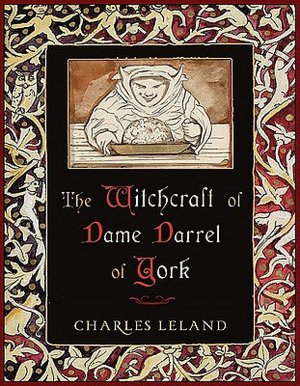
Like the Witches’ Almanac Limited’s republished edition of Leland’s Aradia, this is an absolutely scrumptious volume. Although there is no date in the original hand-made book, Mathiesen estimates that the author created it around 1900. Charles Leland died in 1903, so he did this work toward the end of his life. The original is stored with the Leland papers by the Historical Society of Pennsylvania (collection 363).
This edition is presented in three sections. The first section is Professor Mathiesen’s introduction. He supplies a very good history of Leland, who is one of the most interesting and under-rated characters of the occult and mysticism movement during the late 19th century. Mathiesen discusses the discovery of the book, an analysis of its contents, and biographical information about Leland.
The second section is a full-color photographic facsimile of Leland’s hand-made book. The production of this grimoire was a faithful throw-back to the methods of medieval manuscript production. Leland wrote the text, did the illumination and artwork, sewed the pages together and bound it in vellum. Readers will marvel at Leland’s sumptuous illuminations and marginalia. The text is written within the decorated margins and occasional illustrations. Topic entries are introduced with illuminated capital letters. Leland used red and gold ink in the decorations. The text is hand-written in black, with significant passages underlined in red. It is a visual feast.
The third section is a typeset transcription of the book. Since Leland used extremely creative and inconsistent spelling, obscure words, and optional punctuation, the transcription makes it much easier for the reader to explore the text. Each typeset page is numbered to reflect the manuscript page for easy reference.
Leland chose to write in first person through a fictional narrator, Peronell, a lady from the Isle of Jersey (off the coast of Britain) where French is still spoken. The contents of the grimoire seem to serve as a catch-all for odds and ends that Leland had discovered over the year. With an antique writing and spelling style, Peronell relates the wisdom and sayings of Dame Darrel. For the most part, this consists of a bestiary of magical creatures. Folk tales, spells and charms are woven through the descriptions of different kinds of fairies, elves, giants, animal and tree spirits, demons and devils. Although Leland was an American, Peronell’s charming narrative feels like it was written by a good wife of York during the 17th century. For example:
“A many people theyr be yea and over many who call all this Lere of Faeries foly, and say of elves there ben none and that tis Time lost and Sense wasted to listen to such tales. Of which Dame Darrell would saye whan shee was counsayled to give no hede to Wanton Gospelers and Hereticks, “Be thou not quicke to beleve every new Doctrine yet listen well even to the verie End and heare what the teacher hathe to say.” For ther was once a Tyme God wot, whan al and all y’t wee now believe was called Folly and Falset and was a new Thing. Beare thou thatt in mind.”
(ms page 57, transcription p 239)
Readers who haven’t encountered 16th and 17th century English books may struggle a bit with the obscure spelling, turns of phrase, and terminology. Contemporary readers will be rewarded with Peronell’s good common sense and breadth of knowledge about the magical world, and be charmed by her surprising and gentle humor. Some of the entries discuss the meanings of old forgotten words and terms. Leland gives a good bit of evidence of how Latin, French and Norse terms migrated into medieval English, so the book is also a treasure trove of mystical etymology.
The published volume is available in different formats. There is a hardback edition, a hardback edition with a slip-case, and a leather-bound edition with a slip-case. It’s a beautiful, large coffee-table book. Two ribbons are bound into the spine, and these are useful when referring back and forth between the facsimile and typeset text. This would be a wonderful Yule gift for the witch you love the most.
This is a remarkable and precious document, and well worthy of the meticulous transcription and gorgeous book production efforts that offer the reader delight upon delight. Witches’ Almanac has produced an absolutely top-notch edition of Leland’s magical book. Superb!
~review by Elizabeth Hazel
Author: By Charles Godfrey Leland with an introduction by Professor Robert Mathiesen
The Witches’ Almanac Limited, 2011, published with permission of the Historical Society of Pennsylvania
pp. 361
